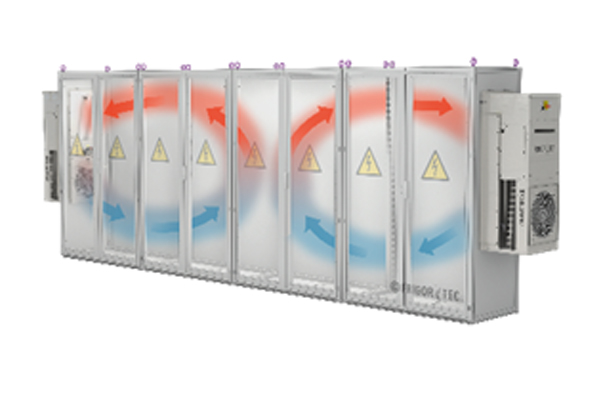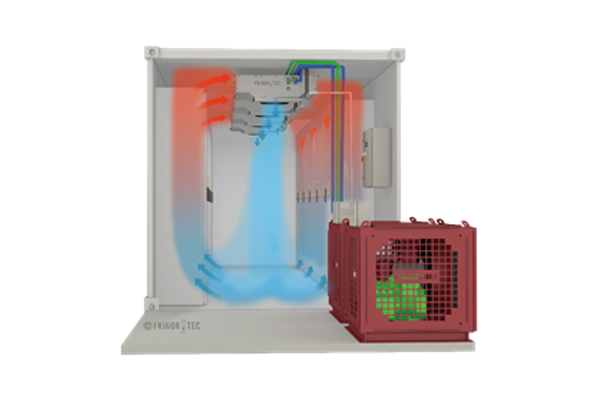Crane Industrial Air Conditioning
We understand that the steel industry requires a high degree of reliability and performance regarding maintaining critical temperature and humidity levels in locations such as: - Machine control centres, Switch gears, Electrical control rooms, Computer control centres, Operator control pulpits, Labs and office space.
- All of our custom-built configurations are assembled by a skilled team of certified technicians. There is no assembly line mentality here.
- Every product we build is subject to quality review and hours of testing before shipping.
Our products operate in extreme environmental conditions including: - Corrosive Environment - Sulphurous and hydrochloric gases, lime and chlorine can destroy exposed Aluminium and copper, and reduce air conditioners to scrap metal quickly.
Frigortec air conditioners, with their heavy-duty frames and epoxy-coated coils are protected from these types of destructive and corrosive elements. - Extreme Temperature - The operating range for Frigortec air conditioners is 15°C to 95°C - High Humidity - Frigortec air conditioners are designed to maintain and control specific relative humidity requirements.
Extreme Levels of Air-Latent Particulates - Airborne particulates found in steel and other metal manufacturing environments are taken into consideration in the design of Frigortec’s heat exchangers.
Excessive Vibration - Steel yard and overhead cranes cause a high degree of vibration. Frigortec AC units are designed with flexible lines and hoses along with rugged frames made of heavy gauge steel to protect equipment from the effects of high vibration environments.
We specialize in the following mentioned Sections of Steel Plants when it comes to High Ambient Temperature Industrial AC.




Applications for AC Units
STEEL MAKING:
The Hot Metal also known as molten pig iron which is produced by Blast Furnaces contains various impurities. Main impurity present is Carbon and other impurities like phosphorus, sulphur, silicon, non-metallic inclusions etc are also present. Steel making is the process of purification of this Hot Metal. Steel such produced is the pure form of metal. Hot Metal contains around 4% of Carbon which is to be reduced below 0.10% as per the requirement. Other impurities like sulphur, phosphorus are also removed and alloying elements such as Manganese, Silicon, Nickel, Chromium and Vanadium are added to produce the exact steel required.
COKE OVENS AND COAL CHEMICALS:
Coke making is the process to convert coking coal, through a series of operations, into metallurgical coke. The process starts from unloading of the coal at the wagon tipplers & ends at sizing & transportation of coke to Blast furnace.
BLAST FURNACES:
BF is a counter current heat and mass exchanger, in which solid raw materials are charged from the top of the furnace and hot blast, is sent through the bottom via tuyeres. The heat is transferred from the gas to the burden and oxygen from the burden to the gas. Gas ascends up the furnace while burden and coke descend down through the furnace. The counter current nature of the reactions makes the overall process an extremely efficient one in reducing atmosphere. The real growth of blast furnace technology came with the production of high strength coke which enabled the construction of large size blast furnaces.
Rolling Mills:
Hot Rolling:
Hot rolling is a metalworking process in which metal is heated above the recrystallization temperature to plastically deform it in the working or rolling operation. This process is used to create shapes with the desired geometrical dimensions and material properties while maintaining the same volume of metal. The hot metal is passed between two rolls to flatten it, lengthen it, reduce the cross-sectional area and obtain a uniform thickness. Hot-rolled steel is the most common product of the hot rolling process and is widely used in the metal industry either as an end product or as raw material for subsequent operations. Hot rolling breaks the grain structures and destroys the boundaries, giving rise to the formation of new structures with strong boundaries having uniform grain structures.
Raw Material Handling Plant (RMHP) or Ore Handling Plant (OHP) or Ore Bedding and Blending Plant (OBBP)
Play a very important role in an Integrated Steel Plant. It is the starting point of an integrated steel plant, where all kinds of raw materials (Except coal) required for iron making/steel making are handled in a systematic manner, e.g., unloading, stacking, screening, crushing, bedding, blending, reclamation, etc.
Cold Rolling:
Purpose of cold reduction is to achieve a reduction in the thickness, a desired surface finish, desirable mechanical properties, close dimensional tolerance and producing as per customer requirements. These thickness reductions are achieved through multi-pass rolling in a reversing mill or tandem mill. Apart from such mills, a cold rolling mill complex may include other facilities for pre-and post-rolling operations.
Sinter Plant:
Sinter plants agglomerate iron ore fines with other fine materials at high temperature, such that constituent materials fuse together to make a single porous mass. A large quantity of iron ore fines is generated in the mines which cannot be charged directly into the Blast furnace. Moreover, many metallurgical wastes are generated in the steel industry itself, disposal of which is very difficult. In order to consume this otherwise waste fine material, they are mixed with Iron ore fines and agglomerated into lumps by a process known as SINTERING. Sintering is the process for agglomeration of fine mineral particles into a Porous and lumpy mass by incipient fusion caused by heat produced by combustion of solid fuel within the mass itself.
We also provide customized solutions for various applications.
- CRANEFRIGOR CK_v + FT
- CK roof unit
- Wall panel control house air-conditioner CK_v
- Roof evaporator Split DV
- Wall-roof Evaporator Split WDV

